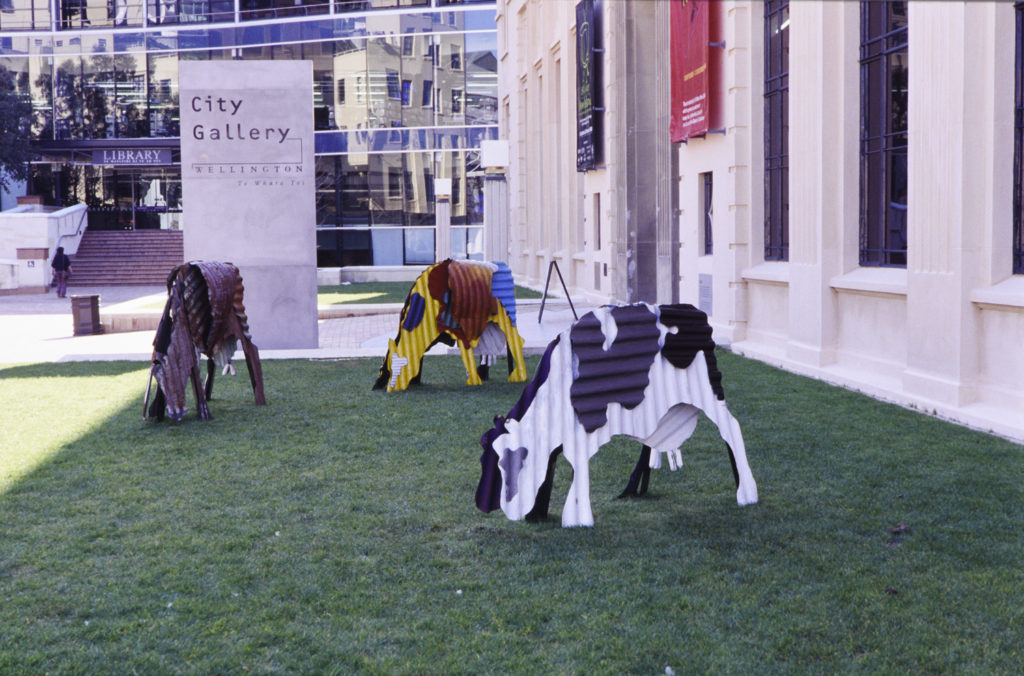CURATORS Stephen Barnett, Frank Stark, Richard Wolfe DESIGNERS Neil Pardington, Andrew Thomas ORGANISER Exhibitour OTHER VENUES Govett-Brewster Art Gallery, New Plymouth, March–April 1993; Waikato Museum of Art and History, Hamilton, June–September 1993; Hastings Exhibition Centre, November 1993–February 1994; Manawatu Museum and Science Centre, Palmerston North, February–June 1994; Dunedin Public Art Gallery, July–October 1994; Robert McDougall Art Gallery, Christchurch, March–July 1995; Auckland Museum, August–October 1995 SPONSORS Instant Kiwi, Huttons Kiwi, Arts Council of New Zealand PUBLICATION New Zealand! New Zealand!: In Praise of Kiwiana, essays Stephen Barnett, Richard Wolfe
Buzzy Bees, Rinso, the Edmonds Cookery Book, etcetera … Kiwiana celebrates distinctive, vernacular New Zealand things from the postwar period—mainstream Pākehā culture. The term 'kiwiana' has come to refer to these national symbols, these objects of nostalgia, these clichés, kitsch. The 200-plus exhibits—from Vegemite to the TV show Country Calender—date from the 1960s or earlier. The show is based on the popular 1990 exhibition New Zealand! New Zealand! at Auckland Museum.
'We've all heard stories about New Zealanders abroad craving Vegemite or Jaffas. This exhibition brings together hundreds of those little things and the effect of seeing them all together is very powerful’, explains the press release.
The show has five sections—the home, childhood, recreation, the farm, and ‘icons’.
‘Home Is Where the Heart Is’ is a typical New Zealand house of the 1950s/early 1960s. The weatherboard exterior wears a wooden butterfly. It includes a fully furnished kitchen and dining room. The back door opens out onto a lawn, complete with lawnmower. In the lounge, Fred Dagg—featuring the stereotypical farmer and Kiwi bloke—plays on the box.
‘Rites of Passage’ portrays the quintessential kiwi childhood, starting with Plunket. It included toys and educational items, such as the School Journal and Janet and John books.
‘The Pursuit of Leisure’ is about the great outdoors, especially the beach—togs, towels, jandals.
‘The Backbone of Country’ takes on farming as key to New Zealand's economy and identity. The kiwi farmer wears a black singlet, Swanndri jacket, and gumboots. The display includes forty-four-gallon drums, kerosene tins, and a 'Taranaki gate’—a makeshift farm gate cobbled together with wire, wood, and kiwi ingenuity.
'Kiwi Icons’ examines the origins of popular national symbols, including the kiwi itself. Ironically, it took an Australian boot polish and a war in Europe for the bird to gain recognition as a symbol at home.
Outside, on the gallery lawn, a small herd of painted corrugated-iron cows by artist Jeff Thompson graze. As part of the opening festivities, the Lochiel Marching Team performs in Civic Square.
The show comes just after Prime Minister Jim Bolger calls for constitutional cuts from the British monarchy, in favour of becoming a republic. Curator Richard Wolfe says, 'in the last ten years or so New Zealand has thrown open the doors to the winds of change and a lot of our companies and institutions have disappeared or changed. We saw it as an opportunity to recognise and celebrate what has been and also to acknowledge change.'
The show is accompanied by the book, New Zealand! New Zealand!: In Praise of Kiwiana, by curators Wolfe and Stephen Barnett.





















